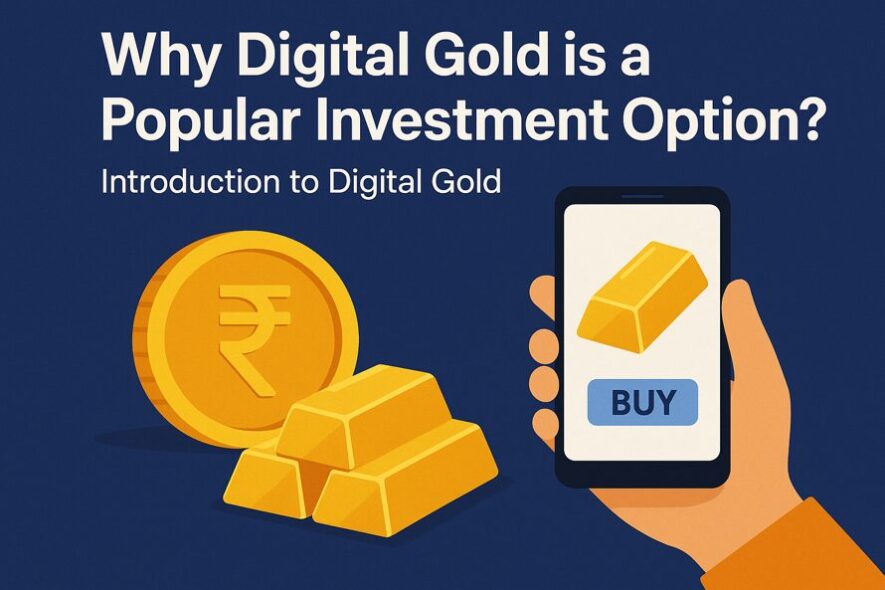
Introduction to Digital Gold
Indians have always trusted gold. For centuries, gold has been the ultimate form of savings, from family heirlooms to festive gifting, and it has never lost its shine. But times have changed. People no longer want to deal with bank lockers, jeweler commissions, or purity doubts. In today’s digital-first world, the way people buy and hold gold has also gone online.
That’s where digital gold steps in. It allows anyone to buy gold instantly using a smartphone, even in tiny amounts, and still enjoy the comfort of knowing that real gold is being held in their name. No trips to jewelry stores, no worry about theft.
This is why investors are convinced digital gold is a popular investment option. Let’s learn more about digital gold and the various options available for investment.
What is Digital Gold?
Digital Gold Explained
Digital gold is a way to buy and own gold online, without physically holding it. For every rupee you invest, the service provider buys an equivalent amount of gold and stores it securely in a professional vault. You remain the legal owner, and at any point, you can sell it back or even ask for delivery in the form of coins and bars.
How It Works in India
In India, buying digital gold is simple. You open a UPI app or an investment platform, select the amount (as low as ₹1), and make the payment. The system automatically allocates the exact quantity of gold at live market rates. This gold is then held in your name with custodians such as MMTC-PAMP, SafeGold, or Augmont. If you decide to sell later, the platform buys it back instantly at the day’s price. If you prefer physical delivery, you can request it; however, minting and delivery charges will apply.
Key Reasons for the Growing Popularity of Digital Gold
Convenience of Online Purchase and Storage
Earlier, buying gold meant visiting a jeweler, negotiating on making charges, worrying about hallmarking, and then finding a safe place to store it. Digital gold removes all these steps. With a few taps, you own gold that is guaranteed pure and stored on your behalf. For city professionals and tech-savvy youth, this level of convenience is unbeatable.
24×7 Accessibility and Liquidity
Unlike stock markets that close at 3:30 p.m., digital gold trades around the clock. You can buy gold at any time, including midnight, weekends, and holidays. Liquidity is equally strong; selling is instant, and money is returned directly to your wallet or bank account.
Low Entry Barrier (Start with ₹1)
This is perhaps the biggest reason behind its success. With digital gold, you don’t need ₹50,000 to buy a chain. You can start with as little as Rs. 1. This feature has made gold accessible to college students, small savers, gig workers, and anyone who wants to start building wealth in micro steps.
Backed by Physical Gold
Investors trust gold only if it’s real. That’s why digital gold providers make sure every rupee is backed by 24k gold stored in insured vaults. This gives people confidence that they’re not just buying a digital entry in an app; they’re holding actual gold through a new channel.
No Worries About Security or Theft
Physical gold always brings questions: where to store it, how to secure it, and whether to pay locker fees. Digital gold solves all these problems. Security is handled at the institutional level, and theft risk is zero. Families that once hesitated to buy extra gold due to storage worries now see digital gold as a stress-free alternative.
Comparison: Digital Gold vs. Physical Gold vs Gold ETFs
Cost and Storage
- Physical Gold: Jewelers charge making fees, and purity can be a concern. Storage requires lockers and insurance.
- Gold ETFs: Lower charges, but you need a Demat account and brokerage. Annual expense ratios apply. You can buy Gold ETFs on platforms such as Lemonn.
- Digital Gold: No locker required, purity assured, storage provided by custodians free of cost up to a limit. For instance, SafeGold doesn’t charge any storage fee for up to five years.
Ease of Transactions
- Buying physical gold means stepping into a shop. Selling requires going back, and jewelers may deduct making charges.
- ETFs trade only during market hours.
- Digital gold is instant, 24/7, and accessible on your smartphone through UPI apps.
Investment Goals and Holding Period
- Physical gold works for long-term family assets and jewelry.
- ETFs suit seasoned investors with Demat accounts looking for large-ticket investments.
- Digital gold sits in between, easy for gifting, saving small amounts, and diversifying without the need for paperwork.
How to Buy Digital Gold in India
Through UPI Apps (PhonePe, Google Pay, Paytm)
Digital gold went mainstream when UPI apps started offering it. Millions of Indians discovered they could buy even 0.01 grams of gold as easily as paying electricity bills or recharging their phones. This integration made adoption effortless.
Via Online Brokers and Investment Platforms
Brokerage firms and wealth management platforms also list digital gold as an entry-level product. Many first-time investors use it as their first investment before moving to mutual funds or equities.
Key Players: MMTC-PAMP, SafeGold, Augmont
Behind the apps stand custodians like MMTC-PAMP, SafeGold, and Augmont. These players ensure vaulting, purity checks, and delivery. They’re the reason trust levels are high, even though the investment itself is digital.
Safety and Regulations Around Digital Gold
Where the Gold Is Stored
The gold you buy isn’t floating in some digital cloud. It’s stored in professional vaults, fully insured against theft or damage. Investors even receive certificates confirming ownership.
SEBI and RBI Oversight Status
Currently, digital gold isn’t directly regulated by SEBI or RBI. However, SEBI is monitoring developments, and many experts believe formal regulation is coming soon. For now, providers follow strict custodial and audit norms to maintain trust.
Transparency and Verification
Every transaction is backed by a digital invoice. Some providers even allow investors to check their holdings against vault records. This level of transparency reassures investors who might otherwise hesitate.
Tax Implications of Digital Gold Investment
Capital Gains Taxation
Tax rules for digital gold are the same as those for physical gold. Returns from digital gold held for 24 months or more are taxed as long-term capital gains (LTCG) at the rate of 12.5% with cess. Short-term capital gains tax applies according to your tax slab.
Holding Period and Indexation
Indexation allows you to adjust the purchase price for inflation. This can significantly reduce your taxable profit if you hold for longer periods. Investors holding digital gold for 5–7 years benefit the most from this rule.
When Should You Invest in Digital Gold?
Ideal for Gifting, Saving, and Portfolio Diversification
Festivals like Diwali and Akshaya Tritiya traditionally involve the purchase of gold. With digital gold, families can gift even small amounts instantly. It’s also a good way to build savings and gradually add diversification to equity-heavy portfolios.
Short- to Medium-Term Wealth Parking
For investors looking to park their money for 1–3 years, digital gold is a practical choice. It provides liquidity, stability, and inflation protection without requiring bulky investments or storage planning.
Limitations of Digital Gold Investment
No Interest or Dividends
Unlike fixed deposits or bonds, digital gold doesn’t generate periodic income. The only return is from price appreciation.
Not Regulated Like Mutual Funds or ETFs
Since it is outside SEBI’s direct oversight, it doesn’t enjoy the same regulatory safety net as mutual funds or ETFs. Investors must rely on platform credibility.
Conversion and Delivery Charges
If you want physical delivery, minting and logistics charges apply. These make it more expensive than buying gold jewelry directly from a store.
Conclusion
Digital gold has carved out a new niche in India’s investment ecosystem. It combines tradition with technology, offering people a way to buy, hold, and sell gold in amounts as small as ₹1. For busy professionals, young savers, and families seeking flexibility, it addresses a very modern need.
No lockers, no theft risks, no big minimums. That’s why digital gold is a popular investment option today. It won’t replace jewelry for weddings or ETFs for large portfolios, but as a supplement, it delivers unmatched convenience.
With UPI apps making gold a part of daily life, digital gold is likely to remain a strong player in India’s savings culture for years to come.
FAQs:
Q. Is digital gold safe and real?
Yes. Every unit of digital gold is backed by real, 24-carat gold stored in secure, insured vaults with providers like MMTC-PAMP, SafeGold, or Augmont. Investors receive invoices and ownership confirmation, ensuring authenticity.
Q. How is digital gold different from gold ETFs?
Gold ETFs trade on stock exchanges and require a Demat account, while digital gold can be bought instantly through UPI apps or platforms without paperwork. ETFs are SEBI-regulated, while digital gold is managed under custodial agreements, though both track the price of physical gold.
Q. What is the minimum amount required to buy digital gold?
One of its biggest attractions is accessibility. You can start with as little as ₹1, making it easy for small savers, students, or anyone experimenting with gold investments.
Q. Can I convert digital gold to physical gold?
Yes. Most platforms allow redemption into coins or bars. You can request delivery, and the gold is shipped to your address. However, minting and delivery charges apply.
Q. Are there hidden charges in digital gold investment?
There are no hidden charges on purchase or sale through apps. Costs typically arise only when you opt for physical delivery, where minting and logistics fees are added.
Q. Is digital gold a good long-term investment?
Digital gold is well-suited for short- to medium-term savings and for gradually building gold reserves. For very long horizons, many investors prefer ETFs or sovereign gold bonds, but digital gold remains valuable for its convenience and flexibility.







